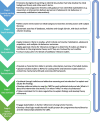Community mobilisation approaches to preventing adolescent multiple risk behaviour: a realist review
- PMID: 38409098
- PMCID: PMC10895861
- DOI: 10.1186/s13643-024-02450-2
Community mobilisation approaches to preventing adolescent multiple risk behaviour: a realist review
Abstract
Background: Adolescent multiple risk behaviour (MRB) is a global health issue. Most interventions have focused on the proximal causes of adolescent MRB such as peer or family influence, with systematic reviews reporting mixed evidence of effectiveness. There is increasing recognition that community mobilisation approaches could be beneficial for adolescent health. There are gaps in the current literature, theory and implementation that would benefit from a realist approach. We use a theory-driven evidence synthesis to assess how and why community mobilisation interventions work/do not work to prevent adolescent MRB and in what contexts.
Methods: This realist review used a six-stage iterative process, guided by the RAMESES framework. We systematically searched PubMed, MEDLINE, PsycINFO, Web of Science, CINAHL and Sociological Abstracts, from their inception to 2021. Studies were screened for relevance to the programme theory, assessed for rigour and included based on a priori criteria. Two independent reviewers selected, screened and extracted data from included studies. A realist logic of analysis was used to develop context-mechanism-outcome configurations that contributed to our programme theory.
Findings: We reviewed 35 documents describing 22 separate community mobilisation intervention studies. Most studies (n = 17) had a quality assessment score of three or four (out of four). We analysed the studies in relation to three middle range theories. To uphold our theory that these interventions work by creating a social environment where adolescents are less likely to engage in MRB, interventions should: (1) embed a framework of guiding principles throughout the community, (2) establish community readiness with population data and (3) ensure a diverse coalition with the support of intervention champions. Mechanisms such as empowerment through coalition ownership over the delivery of the intervention, cohesion across the community and motivation to work collaboratively to improve adolescent health are triggered to achieve social environment shifts. However, certain contexts (e.g. limited funding) restrict intervention success as these mechanisms are not fired.
Conclusions: For community mobilisation interventions to reduce adolescent MRB, the coalitions within them must seek to alter the social environment in which these behaviours occur. Mechanisms including empowerment, cohesion and motivation lead to this shift, but only under certain contexts.
Systematic review registration: PROSPERO CRD42020205342.
Keywords: Adolescence; Community mobilisation; Complex interventions; Inequalities; Realist review; Risk behaviour.
© 2024. The Author(s).
Conflict of interest statement
The authors declare that they have no competing interests.
Figures



Similar articles
-
Community mobilisation approaches to preventing and reducing adolescent multiple risk behaviour: a realist review protocol.Syst Rev. 2021 May 12;10(1):147. doi: 10.1186/s13643-021-01696-4. Syst Rev. 2021. PMID: 33980307 Free PMC article.
-
Beyond the black stump: rapid reviews of health research issues affecting regional, rural and remote Australia.Med J Aust. 2020 Dec;213 Suppl 11:S3-S32.e1. doi: 10.5694/mja2.50881. Med J Aust. 2020. PMID: 33314144
-
Why do acute healthcare staff behave unprofessionally towards each other and how can these behaviours be reduced? A realist review.Health Soc Care Deliv Res. 2024 Aug;12(25):1-195. doi: 10.3310/PAMV3758. Health Soc Care Deliv Res. 2024. PMID: 39239681 Review.
-
Integrating Palliative Care and Heart Failure: the PalliatHeartSynthesis realist synthesis.Health Soc Care Deliv Res. 2024 Sep;12(34):1-128. doi: 10.3310/FTRG5628. Health Soc Care Deliv Res. 2024. PMID: 39324696 Review.
-
Strategies for older people living in care homes to prevent urinary tract infection: the StOP UTI realist synthesis.Health Technol Assess. 2024 Oct;28(68):1-139. doi: 10.3310/DADT3410. Health Technol Assess. 2024. PMID: 39432412 Free PMC article. Review.
References
-
- Hurrelmann K, Richter M. Risk behaviour in adolescence: the relationship between developmental and health problems. J Public Health. 2006;14(1):20–28. doi: 10.1007/s10389-005-0005-5. - DOI
Publication types
MeSH terms
Grants and funding
LinkOut - more resources
Full Text Sources
Medical

